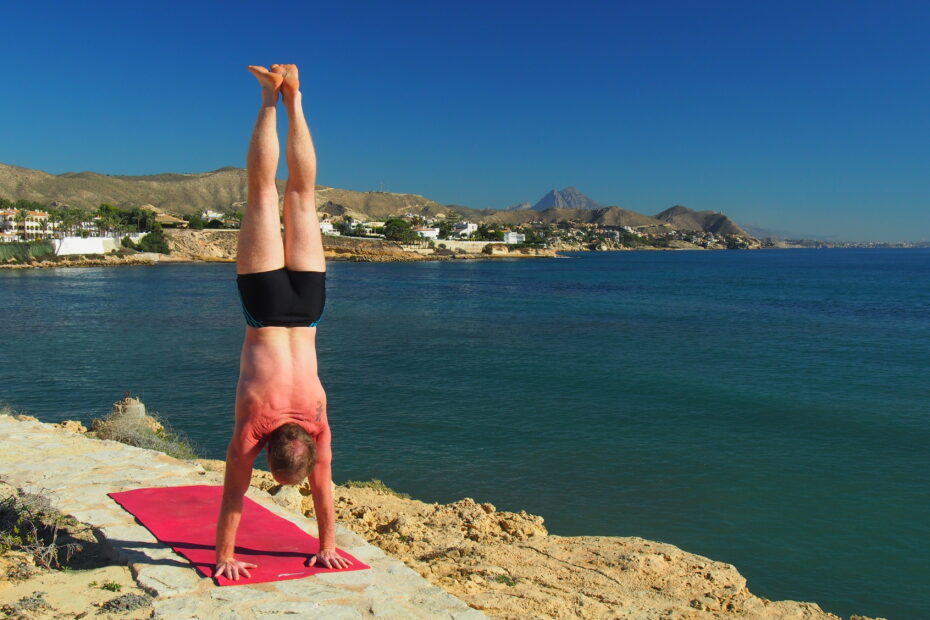Can Help You Succeed as an Acrobat, a Gymnast or a Break Dancer
Watching an acrobat or a gymnast doing deft moves, or a break-dancer twisting her/his body, makes one wonder as to what must be going into training such professionals with elastic bodies having tremendous tenacity.
The Adho Mukha Vrksasana or the ‘downward facing tree’ pose of Yoga is one such body twisting exercise that most of these professionals go through as part of their training. But this exercise can also be taken up by enthusiastic and adventurous youngsters. Those who do acrobatic exercises normally use them as their first step towards a successful entry in any of these professions.
How to do the Handstand
The best way to learn this rather difficult exercise is to first learn the Halasana and follow that up with the Shirashasana (Headstand). The Handstand starts off from where these two exercises stop and is basically an advanced version of the Headstand.
Lie Down and Use Your Hip as the Pivot to Slowly Lift Your Legs
You begin the Handstand by first lying down face-up on a carpet. Breathe easy for the steps to follow. After you feel relaxed, use your hip as the pivot to slowly lift your legs upwards till they are at a right angle with your torso. Learners should pause here and gain confidence to hold their balance. The duration for gaining confidence differs from person to person. Nothing to worry if you take a little longer than others in your team. To balance your legs better, firmly place your palms against your hip and pause for some time before you move to the next step.
Now apply upward pressure on your hip with your palms to help in pushing your back upwards. Slide your palms along your back as it rises from a horizontal position to a vertical one. Your spine should be aligned vertically along with your legs. Take care not to allow your legs to fall forward, or else you could lose your balance.
Use your Shoulders as the Next Pivot to Lift Your Torso
In doing this move it is your shoulders which act as the pivot as did your hip in the first move. Momentum while maintain your balance is the secret of success in this exercise. Cross your arms around your shoulders to form a base and support your torso and legs which are vertically aligned.
Use the Muscles of Your Arms to Lift Your Shoulders
Use your arms to lift your head a bit and slide your palms under it. Spread your fingers so that the wedges are revealed and your palms give you the adequate base necessary for the next difficult step. Now mobilize all the strength in your arms to lift your head free off the ground. Ideally have your Yoga Therapist around to guide you. Also ask a team-mate to hold you steady when you make this move from the Headstand to the Handstand.
As in a Headstand, so also in a Handstand place yourself near the corner of a room as losing your balance while learning is normal. So that when you lose your balance you can swiftly arrest your fall by placing your legs on the wall and regain your posture and composure.
Now the only move to be done is to spread your legs apart. At this posture you appear to look like a tree – hence the name of this asana ‘Downward facing Tree’. There are other more difficult versions of the handstand in which you balance yourself on only one hand and curve your back as a part of a movement during a break-dancing sequence.
How to Come Out of the Handstand
Coming out of the Headstand is as difficult as doing it. Deft moves are called for so do ask your team-mate to be around. To exit from the handstand, bring your legs together and bend them at your knees. Also flex the muscles of your arms and support the movement of your legs. As you fold your legs, also bend your hip while simultaneously tilting your thighs towards your chest.
Gradually move your legs down and place your feet on the floor a yard or so from of your face. Now relax the muscles of your arms and gently push your torso back towards your feet. Use your forearms and legs push help yourself to stand on your feet. Beginners should come out with the support of a partner and learn this complicated exercise under the guidance of a Yoga Therapist.
Those who would go for this exercise would be young and robust but do consult your doctor before you start off on this posture.
Physical Benefits of the Handstand
The physical benefit of doing the handstand is that your brain gets an added flow of blood. Consequently your brain cells get nourished and you can improve your eyesight, your memory and reduce hair loss. In addition the muscles of your arms are strengthened.
Professional Benefits of the Handstand
Most of you who learn this challenging exercise would have professional goals in mind. Mastering the Handstand and be able to do it with dexterity is your first step towards becoming a successful acrobat, gymnast, or break-dancer. By executing the Handstand skillfully you gain the necessary agility and confidence to weave this posture into other movements and sequences, be they in gymnastics, acrobatics or dancing.
